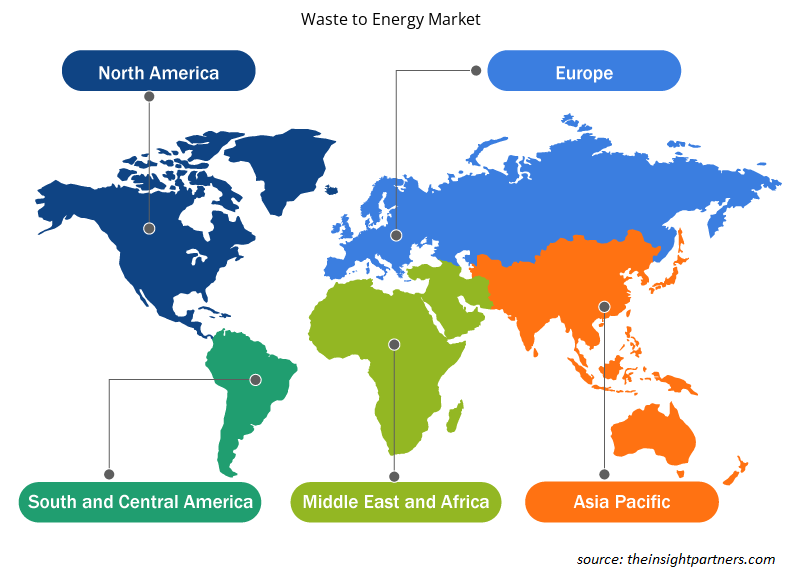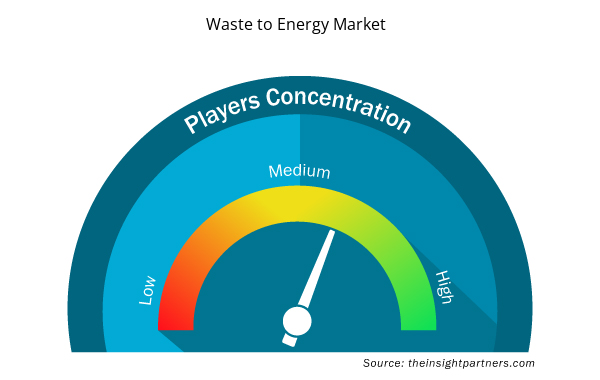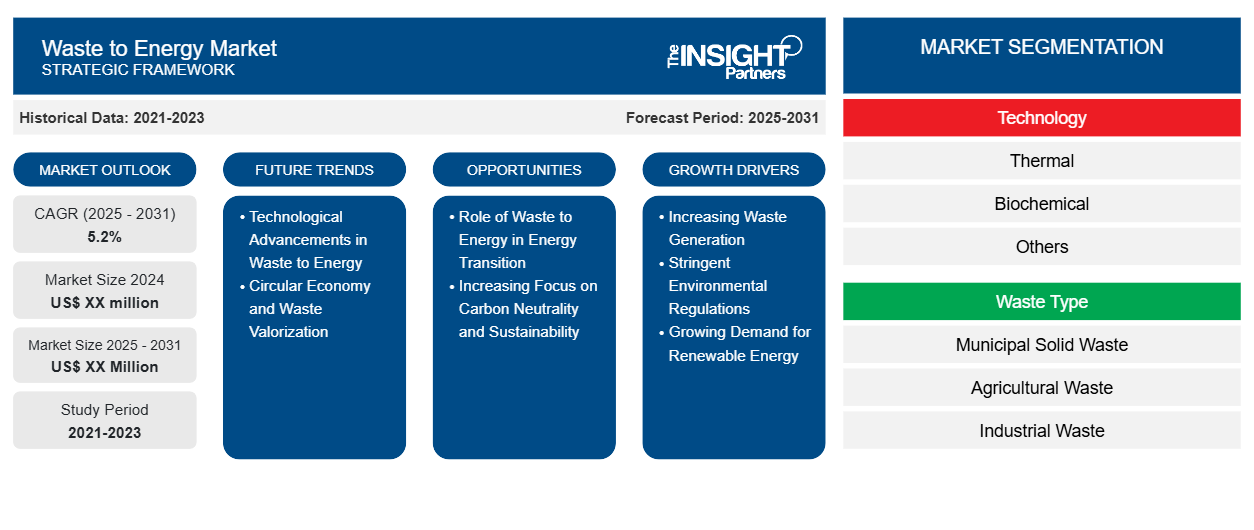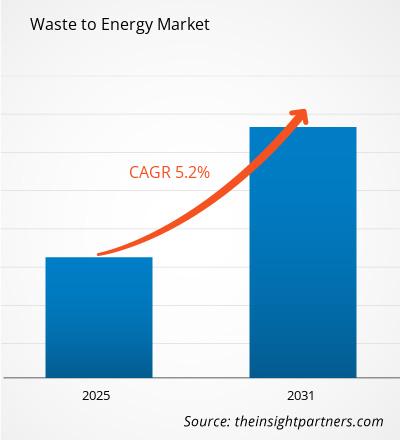Se espera que el mercado de conversión de residuos en energía registre una CAGR del 5,2 % entre 2023 y 2031, y que el tamaño del mercado se amplíe de XX millones de dólares en 2023 a XX millones de dólares en 2031.
El informe está segmentado por tecnología (térmica, bioquímica, otras). El informe presenta además un análisis basado en el tipo de residuo (residuos sólidos urbanos, residuos agrícolas, residuos industriales, otros). El informe presenta además un análisis basado en la aplicación (generación de electricidad, calefacción, transporte). El análisis global se desglosa aún más a nivel regional y por países principales. El informe ofrece el valor en USD para el análisis y los segmentos anteriores.
Propósito del Informe
El informe Waste to Energy Market de The Insight Partners tiene como objetivo describir el panorama actual y el crecimiento futuro, los principales factores impulsores, los desafíos y las oportunidades. Esto proporcionará información a diversas partes interesadas del negocio, como:
- Proveedores/fabricantes de tecnología: Para comprender la dinámica cambiante del mercado y conocer las oportunidades potenciales de crecimiento, lo que les permitirá tomar decisiones estratégicas informadas.
- Inversionistas: Realizar un análisis exhaustivo de tendencias sobre la tasa de crecimiento del mercado, las proyecciones financieras del mercado y las oportunidades que existen en toda la cadena de valor.
- Órganos reguladores: Regular las políticas y vigilar las actividades del mercado con el objetivo de minimizar los abusos, preservar la confianza de los inversores y defender la integridad y la estabilidad del mercado.
Segmentación del mercado de conversión de residuos en energía
Tecnología
- Térmico
- Bioquímico
- Otros
Tipo de residuo
- Residuos sólidos municipales
- Residuos agrícolas
- Desechos industriales
- Otros
Solicitud
- Generación de electricidad
- Calefacción
- Transporte
Geografía
- América del norte
- Europa
- Asia-Pacífico
- América del Sur y Central
- Oriente Medio y África
Geografía
- América del norte
- Europa
- Asia-Pacífico
- América del Sur y Central
- Oriente Medio y África
Personalice este informe según sus necesidades
Obtendrá personalización en cualquier informe, sin cargo, incluidas partes de este informe o análisis a nivel de país, paquete de datos de Excel, así como también grandes ofertas y descuentos para empresas emergentes y universidades.
- Obtenga las principales tendencias clave del mercado de este informe.Esta muestra GRATUITA incluirá análisis de datos, desde tendencias del mercado hasta estimaciones y pronósticos.
Factores que impulsan el crecimiento del mercado de conversión de residuos en energía
- Aumento de la generación de residuos: con el aumento de las poblaciones urbanas y de las economías industrializadas, a nivel mundial, la cantidad de residuos generados es cada vez mayor. Las presiones para los vertederos y los viejos sistemas de gestión de residuos aumentan junto con esta tendencia creciente. Por lo tanto, la tecnología WtE proporciona una respuesta a un desafío crítico que plantea el aumento constante de los residuos, produciendo electricidad al mismo tiempo. Con los vertederos cada vez más congestionados y las regulaciones cada vez más estrictas en torno a la eliminación de residuos, la conversión de los residuos en energía se ha convertido en la alternativa preferida, lo que ha contribuido al crecimiento del mercado de WtE.
- Normas ambientales estrictas: los gobiernos de todo el mundo están imponiendo normas ambientales más estrictas para controlar el impacto ambiental de las prácticas de gestión de residuos. Las tecnologías antiguas, como el vertido en vertederos y la incineración sin recuperación de energía, están cada vez más prohibidas o reguladas, ya que son degradantes para el medio ambiente y tienen efectos nocivos en la contaminación del suelo y la emisión de metano. Las normas instan a las tecnologías de WtE a llenar este vacío, ya que ayudan a reducir el volumen de residuos, disminuyen las emisiones y respaldan el objetivo de reducción de carbono, estimulando así la demanda de soluciones de WtE.
- Demanda creciente de energía renovable: Existe un cambio global creciente hacia fuentes de energía renovables a medida que los países se esfuerzan por cumplir sus objetivos climáticos y reducir la dependencia de los combustibles fósiles. La conversión de residuos en energía se considera una fuente de energía renovable porque reduce los residuos al tiempo que genera electricidad, calor o combustibles. El creciente énfasis en la adopción de energía renovable, junto con la necesidad de diversificar las fuentes de energía, ha creado una fuerte demanda de tecnologías de conversión de residuos en energía. Por lo tanto, la conversión de residuos en energía es una de las soluciones prometedoras que se pueden utilizar en combinación con otras fuentes renovables, como la solar, la eólica y la hidroeléctrica.
Tendencias futuras del mercado de conversión de residuos en energía
- Avances tecnológicos en la conversión de residuos en energía: los recientes avances en las tecnologías de conversión de residuos en energía, incluidas las tecnologías térmicas avanzadas como la pirólisis y la gasificación, y los procesos biológicos, como la digestión anaeróbica, han abierto importantes oportunidades en el mercado. Estas tecnologías se están volviendo eficientes, rentables y respetuosas con el medio ambiente. La gasificación, por ejemplo, se está explorando más, ya que puede convertir más materiales de desecho en mejor combustible o electricidad, y la digestión anaeróbica es otra forma prometedora de convertir los residuos orgánicos en biogás. Las innovaciones en captura de carbono y eficiencia energética también están abriendo nuevas vías para el crecimiento en el sector de conversión de residuos en energía.
- Economía circular y valorización de residuos: El concepto de economía circular, en el que los productos y materiales se reutilizan, reparan y reciclan, está ganando mucho impulso en todo el mundo. Por lo tanto, las tecnologías WtE encajan perfectamente en este esquema, ya que no solo ayudan a abordar el problema de la eliminación de residuos, sino que también generan energía y subproductos valiosos como biocombustibles, productos químicos y calor. La valorización de residuos o la maximización del valor de los residuos ha estado ganando mayor atención, creando así un potencial significativo para el mercado de WtE. Las plantas WtE poseen capacidades tanto de generación de energía como de gestión de residuos y, por lo tanto, desempeñan un papel importante en la economía circular.
Oportunidades de mercado para la conversión de residuos en energía
- El papel de la conversión de residuos en energía en la transición energética: La transición energética es la transición de la dependencia de los combustibles fósiles a fuentes de energía renovables y más limpias. Este cambio responde a la necesidad urgente de soluciones energéticas sostenibles y respetuosas con el medio ambiente. En las últimas décadas se ha producido un aumento de las emisiones de dióxido de carbono (CO2), lo que contribuye al cambio climático. La transición a fuentes de energía renovables y respetuosas con el medio ambiente es una estrategia fundamental para reducir estas emisiones y mitigar el daño ambiental. Se espera que esta transición energética mediante la conversión de residuos en energía o combustible sea la tendencia clave en el mercado de conversión de residuos en energía en los próximos años.
- Mayor enfoque en la neutralidad de carbono y la sostenibilidad: este enfoque es parte del esfuerzo internacional por alcanzar los objetivos climáticos globales y se está volviendo más pronunciado a través de la neutralidad de carbono y las soluciones energéticas sostenibles. Las tecnologías WtE ayudan a reducir las emisiones de gases de efecto invernadero, ya que desvían los desechos de los vertederos, lo que reduce las emisiones de metano y genera energía limpia. Las empresas y los países que establecen objetivos ambiciosos de sostenibilidad aumentarán la demanda de soluciones WtE. Las tecnologías WtE que están equipadas para capturar y secuestrar carbono serán cada vez más atractivas como parte de una estrategia integrada para mitigar los efectos del cambio climático.
Perspectivas regionales sobre el mercado de conversión de residuos en energía
Los analistas de Insight Partners explicaron en detalle las tendencias y los factores regionales que influyen en el mercado de conversión de residuos en energía durante el período de pronóstico. Esta sección también analiza los segmentos y la geografía del mercado de conversión de residuos en energía en América del Norte, Europa, Asia Pacífico, Oriente Medio y África, y América del Sur y Central.

- Obtenga los datos regionales específicos para el mercado de conversión de residuos en energía
Alcance del informe sobre el mercado de conversión de residuos en energía
| Atributo del informe | Detalles |
|---|---|
| Tamaño del mercado en 2023 | XX millones de dólares estadounidenses |
| Tamaño del mercado en 2031 | US$ XX millones |
| Tasa de crecimiento anual compuesta (CAGR) global (2023-2031) | 5,2% |
| Datos históricos | 2021-2022 |
| Período de pronóstico | 2024-2031 |
| Segmentos cubiertos | Por tecnología
|
| Regiones y países cubiertos | América del norte
|
| Líderes del mercado y perfiles de empresas clave |
|
Densidad de actores del mercado de conversión de residuos en energía: comprensión de su impacto en la dinámica empresarial
El mercado de conversión de residuos en energía está creciendo rápidamente, impulsado por la creciente demanda de los usuarios finales debido a factores como la evolución de las preferencias de los consumidores, los avances tecnológicos y una mayor conciencia de los beneficios del producto. A medida que aumenta la demanda, las empresas amplían sus ofertas, innovan para satisfacer las necesidades de los consumidores y aprovechan las tendencias emergentes, lo que impulsa aún más el crecimiento del mercado.
La densidad de actores del mercado se refiere a la distribución de las empresas o firmas que operan dentro de un mercado o industria en particular. Indica cuántos competidores (actores del mercado) están presentes en un espacio de mercado determinado en relación con su tamaño o valor total de mercado.
Las principales empresas que operan en el mercado de conversión de residuos en energía son:
- Grupo AEandE GmbH
- Arrow Ecología Limitada
- Empresas Babcock y Wilcox Inc.
- Construcciones Industrielles De La Mediterranee SA
- Corporación Energética Covanta
Descargo de responsabilidad : Las empresas enumeradas anteriormente no están clasificadas en ningún orden particular.

- Obtenga una descripción general de los principales actores clave del mercado de conversión de residuos en energía
Puntos de venta clave
- Cobertura integral: el informe cubre de manera integral el análisis de productos, servicios, tipos y usuarios finales del mercado de residuos a energía, proporcionando un panorama holístico.
- Análisis de expertos: el informe se compila sobre la base de un profundo conocimiento de expertos y analistas de la industria.
- Información actualizada: El informe asegura relevancia comercial debido a su cobertura de información reciente y tendencias de datos.
- Opciones de personalización: este informe se puede personalizar para satisfacer los requisitos específicos del cliente y adaptarse adecuadamente a las estrategias comerciales.
Por lo tanto, el informe de investigación sobre el mercado de conversión de residuos en energía puede ayudar a abrir el camino para descifrar y comprender el escenario de la industria y las perspectivas de crecimiento. Si bien puede haber algunas preocupaciones válidas, los beneficios generales de este informe tienden a superar las desventajas.
- Análisis histórico (2 años), año base, pronóstico (7 años) con CAGR
- Análisis PEST y FODA
- Tamaño del mercado Valor/volumen: global, regional, nacional
- Industria y panorama competitivo
- Conjunto de datos de Excel



Report Coverage
Revenue forecast, Company Analysis, Industry landscape, Growth factors, and Trends

Segment Covered
This text is related
to segments covered.

Regional Scope
North America, Europe, Asia Pacific, Middle East & Africa, South & Central America

Country Scope
This text is related
to country scope.
Preguntas frecuentes
Some of the customization options available based on the request are an additional 3-5 company profiles and country-specific analysis of 3-5 countries of your choice. Customizations are to be requested/discussed before making final order confirmation, as our team would review the same and check the feasibility.
The report can be delivered in PDF/PPT format; we can also share excel dataset based on the request.
The leading players operating in the Waste to Energy Market include Mitsubishi Heavy Industries Ltd., A2A S.p.A., Veolia Environnement SA, Martin GmbH, Hitachi Zosen Corp., Ramboll Group A/S, EEW Holding GmbH, Tana Oy, SUEZ, STEAG Energy Services GmbH
Technological Advancements in Waste to Energy is the key future trend of the Waste to Energy Market
The Waste to Energy Market is estimated to witness a CAGR of 5.2% from 2023 to 2031
The major factors driving the Waste to Energy Market are: Increasing Waste Generation and Stringent Environmental Regulations
Trends and growth analysis reports related to Energy and Power : READ MORE..
1. AEandE Group Gmbh2. Arrow Ecology Limited3. Babcock and Wilcox Enterprises Inc.4. Constructions Industrielles De La Mediterranee S.A.5. Covanta Energy Corporation6. Essent N.V.7. Haase Energietechnik AG8. John Wood Group PLC9. Pacific Renewable Fuels Inc10. Qinetiq Group Plc
The Insight Partners performs research in 4 major stages: Data Collection & Secondary Research, Primary Research, Data Analysis and Data Triangulation & Final Review.
- Data Collection and Secondary Research:
As a market research and consulting firm operating from a decade, we have published and advised several client across the globe. First step for any study will start with an assessment of currently available data and insights from existing reports. Further, historical and current market information is collected from Investor Presentations, Annual Reports, SEC Filings, etc., and other information related to company’s performance and market positioning are gathered from Paid Databases (Factiva, Hoovers, and Reuters) and various other publications available in public domain.
Several associations trade associates, technical forums, institutes, societies and organization are accessed to gain technical as well as market related insights through their publications such as research papers, blogs and press releases related to the studies are referred to get cues about the market. Further, white papers, journals, magazines, and other news articles published in last 3 years are scrutinized and analyzed to understand the current market trends.
- Primary Research:
The primarily interview analysis comprise of data obtained from industry participants interview and answers to survey questions gathered by in-house primary team.
For primary research, interviews are conducted with industry experts/CEOs/Marketing Managers/VPs/Subject Matter Experts from both demand and supply side to get a 360-degree view of the market. The primary team conducts several interviews based on the complexity of the markets to understand the various market trends and dynamics which makes research more credible and precise.
A typical research interview fulfils the following functions:
- Provides first-hand information on the market size, market trends, growth trends, competitive landscape, and outlook
- Validates and strengthens in-house secondary research findings
- Develops the analysis team’s expertise and market understanding
Primary research involves email interactions and telephone interviews for each market, category, segment, and sub-segment across geographies. The participants who typically take part in such a process include, but are not limited to:
- Industry participants: VPs, business development managers, market intelligence managers and national sales managers
- Outside experts: Valuation experts, research analysts and key opinion leaders specializing in the electronics and semiconductor industry.
Below is the breakup of our primary respondents by company, designation, and region:

Once we receive the confirmation from primary research sources or primary respondents, we finalize the base year market estimation and forecast the data as per the macroeconomic and microeconomic factors assessed during data collection.
- Data Analysis:
Once data is validated through both secondary as well as primary respondents, we finalize the market estimations by hypothesis formulation and factor analysis at regional and country level.
- Macro-Economic Factor Analysis:
We analyse macroeconomic indicators such the gross domestic product (GDP), increase in the demand for goods and services across industries, technological advancement, regional economic growth, governmental policies, the influence of COVID-19, PEST analysis, and other aspects. This analysis aids in setting benchmarks for various nations/regions and approximating market splits. Additionally, the general trend of the aforementioned components aid in determining the market's development possibilities.
- Country Level Data:
Various factors that are especially aligned to the country are taken into account to determine the market size for a certain area and country, including the presence of vendors, such as headquarters and offices, the country's GDP, demand patterns, and industry growth. To comprehend the market dynamics for the nation, a number of growth variables, inhibitors, application areas, and current market trends are researched. The aforementioned elements aid in determining the country's overall market's growth potential.
- Company Profile:
The “Table of Contents” is formulated by listing and analyzing more than 25 - 30 companies operating in the market ecosystem across geographies. However, we profile only 10 companies as a standard practice in our syndicate reports. These 10 companies comprise leading, emerging, and regional players. Nonetheless, our analysis is not restricted to the 10 listed companies, we also analyze other companies present in the market to develop a holistic view and understand the prevailing trends. The “Company Profiles” section in the report covers key facts, business description, products & services, financial information, SWOT analysis, and key developments. The financial information presented is extracted from the annual reports and official documents of the publicly listed companies. Upon collecting the information for the sections of respective companies, we verify them via various primary sources and then compile the data in respective company profiles. The company level information helps us in deriving the base number as well as in forecasting the market size.
- Developing Base Number:
Aggregation of sales statistics (2020-2022) and macro-economic factor, and other secondary and primary research insights are utilized to arrive at base number and related market shares for 2022. The data gaps are identified in this step and relevant market data is analyzed, collected from paid primary interviews or databases. On finalizing the base year market size, forecasts are developed on the basis of macro-economic, industry and market growth factors and company level analysis.
- Data Triangulation and Final Review:
The market findings and base year market size calculations are validated from supply as well as demand side. Demand side validations are based on macro-economic factor analysis and benchmarks for respective regions and countries. In case of supply side validations, revenues of major companies are estimated (in case not available) based on industry benchmark, approximate number of employees, product portfolio, and primary interviews revenues are gathered. Further revenue from target product/service segment is assessed to avoid overshooting of market statistics. In case of heavy deviations between supply and demand side values, all thes steps are repeated to achieve synchronization.
We follow an iterative model, wherein we share our research findings with Subject Matter Experts (SME’s) and Key Opinion Leaders (KOLs) until consensus view of the market is not formulated – this model negates any drastic deviation in the opinions of experts. Only validated and universally acceptable research findings are quoted in our reports.
We have important check points that we use to validate our research findings – which we call – data triangulation, where we validate the information, we generate from secondary sources with primary interviews and then we re-validate with our internal data bases and Subject matter experts. This comprehensive model enables us to deliver high quality, reliable data in shortest possible time.


 Obtenga una muestra gratuita de este informe
Obtenga una muestra gratuita de este informe